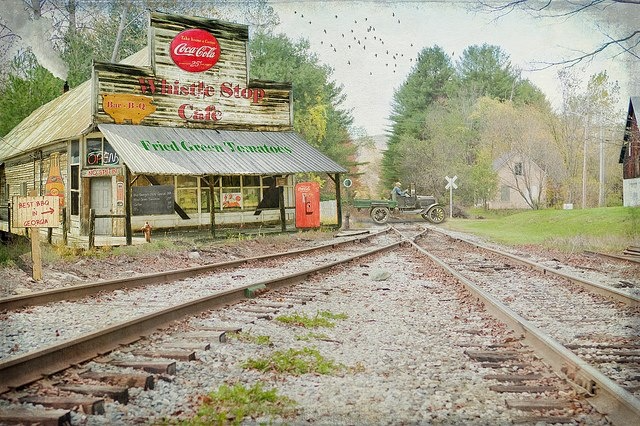
In Fried Green Tomatoes, many of the most powerful moments don’t happen in dramatic courtrooms or bustling diners. They unfold in the quiet spaces — beside rivers, in dusty backyards, or under a tree near a set of train tracks. That tree, where Ruth and Idgie often sit together, becomes more than just a background. It’s a symbol of safety, rebirth, and the kind of love that doesn’t need permission.
The Tracks as Borderlines
The train tracks that run past Whistle Stop are more than infrastructure — they symbolize transition, escape, and change. For Ruth, they represent the boundary between a past filled with abuse and a future full of uncertainty. For Idgie, they’re a link to adventure, memory, and the loss of her beloved brother Buddy.
But the tree beside those tracks interrupts the hard, linear symbolism of the rails. It offers shade, stillness, and permanence. Trains may roar past, carrying people away, but that tree stays rooted — just like the friendship between the two women.
A Place Without Words

Some of the most emotionally charged scenes between Ruth and Idgie happen under that tree — without dialogue. Whether they’re sharing peaches, reading aloud, or just sitting in silence, there is a tenderness that says more than words ever could.
This silence is significant. In a time and place where women, especially queer women, had little freedom to speak openly, the tree becomes a refuge. A place where they can simply be — no expectations, no fear.
A Living Witness
That tree bears witness to their evolving relationship. In the early scenes, it’s a meeting point — cautious, lighthearted. Later, it becomes a symbol of commitment, as they return again and again, sharing stories, fears, and dreams.
It sees Ruth’s joy when Buddy Jr. is born. It sees Idgie’s grief when Ruth falls ill. It stands through all seasons, silently watching love, loss, and transformation.
Nature as Healer
In Southern literature and film, nature often serves as a healing force. The tree near the tracks fits this tradition perfectly. Surrounded by open land, far from prying eyes, it gives space for emotional freedom.
Ruth, whose body and soul have been broken by her marriage to Frank, begins to soften, to laugh, to trust again under that tree. Idgie, wild and guarded since her brother’s death, begins to open up, risking vulnerability for the first time in years.
The tree becomes their confessional, their sanctuary, and eventually, a sacred memory.
Echoes in the Present
In the film’s present-day scenes with Evelyn and Ninny, the physical tree is never shown again. But its spirit lingers. Ninny’s stories — especially the ones she tells in the garden or by the nursing home window — carry the same tone as those scenes by the tree: gentle, honest, slightly sad but full of life.
It’s as though the tree is still standing somewhere, not on screen, but in memory, carrying within its bark the love and pain of those long gone.
Conclusion: Where Time Stands Still
The tree by the tracks in Fried Green Tomatoes may not get much attention. It isn’t named, or directly discussed. But it serves as one of the film’s most profound symbols. A place where time slows, where the pain of the outside world fades, and where two women can sit side by side without explanation.
In a story about memory, love, and resistance, the tree is a quiet constant — offering not just shelter from the sun, but shelter from judgment.
And long after the final credits roll, we remember that spot — not because something dramatic happened there, but because everything did.
